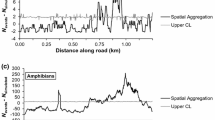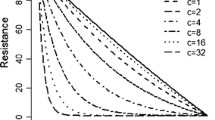Abstract
Context
Managers are faced with numerous methods for delineating wildlife movement corridors, and often must make decisions with limited data. Delineated corridors should be robust to different data and models.
Objectives
We present a multi-method approach for delineating and validating wildlife corridors using multiple data sources, which can be used conserve landscape connectivity. We used this approach to delineate and validate migration corridors for wildebeest (Connochaetes taurinus) in the Tarangire Ecosystem of northern Tanzania.
Methods
We used two types of locational data (distance sampling detections and GPS collar locations), and three modeling methods (negative binomial regression, logistic regression, and Maxent), to generate resource selection functions (RSFs) and define resistance surfaces. We compared two corridor detection algorithms (cost-distance and circuit theory), to delineate corridors. We validated corridors by comparing random and wildebeest locations that fell within corridors, and cross-validated by data type.
Results
Both data types produced similar RSFs. Wildebeest consistently selected migration habitat in flatter terrain farther from human settlements. Validation indicated three of the combinations of data type, modeling, and corridor detection algorithms (detection data with Maxent modeling, GPS collar data with logistic regression modeling, and GPS collar data with Maxent modeling, all using cost-distance) far outperformed the other seven. We merged the predictive corridors from these three data-method combinations to reveal habitat with highest probability of use.
Conclusions
The use of multiple methods ensures that planning is able to prioritize conservation of migration corridors based on all available information.




Similar content being viewed by others
References
Adriaensen F, Chardon JP, De Blust G, Swinnen E, Villalba S, Gulnick H, Matthysen E (2003) The application of “least cost” modelling as a functional landscape model. Landsc Urban Plan 64:233–247
Beier P, Majka DR, Spencer WD (2008) Forks in the road: choices in procedures for designing wildland linkages. Conserv Biol 22:836–851
Berger J (2004) The last mile: how to sustain long-distance migration in mammals. Conserv Biol 18:320–331
Berry HH, Louw GN (1982) Seasonal nutritive status of wildebeest in Etosha National Park. Modoqua 13:127–139
Bolger DT, Newmark WD, Morrison TA, Doak DF (2008) The need for integrative approaches to understand and conserve migratory ungulates. Ecol Lett 11:63–77
Borner M (1985) The increasing isolation of Tarangire National Park. Oryx 19:91–96
Burnham KP, Anderson DR (2002) Model selection and multimodel inference: a practical information-theoretical approach. Springer-Verlag, New York
Caro T, Jones T, Davenport T (2009) Realities of documenting wildlife corridors in tropical countries. Biol Conserv 142:2807–2811
Cushman SA, McRae B, Adriaensen F, Beier P, Shirley M, Zeller K (2013) Biological corridors and connectivity. In: Macdonald DW, Willis KJ (eds) Key topics in conservation biology 2, 1st edn. Wiley, Oxford, pp 384–404
Elith J, Phillips SJ, Hastie T, Dudík M, Chee Yung En, Yates CJ (2011) A statistical explanation of MaxEnt for ecologists. Divers Distrib 17:43–57
Epps CW, Mutayoba BM, Gwin L, Brashares JS (2011) An empirical evaluation of the African elephant as a focal species for connectivity planning in East Africa. Divers Distrib 17:603–6012
ESRI Environmental Systems Research Institute (2016) ArcGIS Desktop: Release 10.4. Redlands
Estes RD (2014) The Gnu’s World: Serengeti wildebeest ecology and life history. University of California Press, Berkeley
Foley CA, Faust LJ (2010) Rapid population growth in an elephant Loxodonta africana population recovering from poaching in Tarangire National Park, Tanzania. Oryx 44:205–212
Fryxell JM, Greever J, Sinclair ARE (1988) Why are migratory ungulates so abundant? Am Nat 131:781–798
Georgiadis N (1995) Population structure of wildebeest: implications for conservation. In: Sinclair ARE, Arcese P (eds) Serengeti II: dynamics, management and conservation of an ecosystem. University of Chicago Press, Chicago
Hamilton EW, Giovannini MS, Moses SA, Coleman JS, McNaughton SJ (1998) Biomass and mineral element responses of a Serengeti short-grass species to nitrogen supply and defoliations: compensation requires a critical [N]. Oecologia 116:407–418
Harris G, Thirgood S, Hopcraft JGC, Cromsigt JPGM, Berger J (2009) Global decline in aggregated migrations of large terrestrial mammals. Endanger Species Res 7:55–76
Hebblewhite M, Haydon DT (2010) Distinguishing technology from biology: a critical review of the use of GPS telemetry data in ecology. Philios Trans R Soc B Biol Sci 365:2303–2312
Holdo RM, Holt RD, Fryxell JM (2009) Opposing rainfall and plant nutritional gradients best explain the wildebeest migration in the Serengeti. Am Nat 173:431–445
Hopcraft J, Morales J, Beyer H, Borner M, Mwangomo E, Sinclair A, Olff H, Haydon D (2014) Competition, predation and migration: individual choice patterns of Serengeti migrants captured by hierarchical models. Ecol Monogr 84:355–372
Horne JS, Garton EO, Krone SM, Lewis JS (2007) Analyzing animal movements using Brownian bridges. Ecology 88:2354–2363
Kiffner C, Albertini M, Ede A, Donnellan B, Hahn N, McGinnis MA, Nietlisbach NA, Tate J, Kioko J (2015) Performance of individual species as indicators of large mammal species richness in Northern Tanzania. Ecol Indic 53:70–77
Lamprey HF (1964) Estimation of the large mammal densities, biomass and energy exchange in the Tarangire Game Reserve and the Masai Steppe in Tanganyika. East Afr J Wildl 2:1–46
LaPoint S, Gallery P, Wikelski M, Kays R (2013) Animal behavior, cost-based corridor models, and real corridors. Landscape Ecol 28:1615–1630
Lee DL, Kissui BM, Kiwango YA, Bond ML (2016) Migratory herds of wildebeests and zebras indirectly affect calf survival of giraffes. Ecol Evol 6:8402–8411
Manly BF, McDonald LL, Thomas DL, McDonald DL, Erickson WP (2002) Resource selection by animals: statistical analysis and design for field studies. Kluwer, Dordrecht
McClure ML, Hanson AJ, Inman RM (2016) Connecting models to movements: testing connectivity model predictions against empirical migration and dispersal data. Landscape Ecol. doi:10.1007/s10980-016-0347-0
McNaughton SJ (1985) Ecology of a grazing ecosystem: the Serengeti. Ecol Monogr 55:259–294
McRae B, Dickson B, Keitt T, Shah V (2008) Using circuit theory to model connectivity in ecology, evolution, and conservation. Ecology 89:2712–2724
McRae B, Shah V (2008) Circuitscape User Guide. University of California, Santa Barbara
McRae BH, Kavanagh DM (2011) Linkage Mapper Connectivity Analysis Software. The Nature Conservancy, Seattle. www.waconnected.org/habitat-connectivity-mapping-tools.php
Morales JM, Haydon DT, Frair J, Holsiner KE, Fryxell JM (2004) Extracting more out of relocation data: building movement models as mixtures of random walks. Ecology 85:2436–2445
Morrison TA, Bolger DT (2012) Wet season range fidelity in a tropical migratory ungulate. J Anim Ecol 81:543–552
Morrison TA, Bolger DT (2014) Connectivity and bottlenecks in a migratory wildebeest Connochaetes taurinus population. Oryx 48:613–621
Morrison TA, Link WA, Newmark WD, Foley CAH, Bolger DT (2016) Tarangire revisited: consequences of declining connectivity in a tropical ungulate population. Biol Conserv 197:53–60
Msoffe FU, Said MY, Ogutu JO, Kifugo SC, de Leeuw J, van Gardingen P, Reid RS (2011) Spatial correlates of land-use changes in the Maasai-Steppe of Tanzania: implications for conservation and environmental planning. Int J Biodiver Conserv 3:280–290
Newmark WD (2008) Isolation of African protected areas. Front Ecol Environ 6:321–328
Nielson RM, Sawyer H (2013) Estimating resource selection with count data. Ecol Evol 3:2233–2240
Phillips SJ, Anderson RP, Schapire RE (2006) Maximum entropy modeling of species geographic distributions. Ecol Model 190:231–259
Poor EE, Loucks C, Jakes A, Urban DL (2012) Comparing habitat suitability and connectivity modeling methods for conserving pronghorn migrations. PLoS ONE 7(11):e49390
Prins HHT (1987) Nature conservation as an integral part of optimal land use in East Africa: action plan for the Masai ecosystem of northern Tanzania. Biol Conserv 40:141–161
Pullinger MG, Johnson CJ (2010) Maintaining or restoring connectivity of modified landscapes: evaluating the least-cost path model with multiple sources of ecological information. Landscape Ecol 25:1547–1560
R Core Development Team (2013) R: a language and environment for statistical computing. R Foundation for Statistical Computing, Vienna Austria
Reid R (2012) Savannas of our birth: people, wildlife, and change in East Africa. University of California Press, Berkeley
Sawyer H, Kauffman MJ (2011) Stopover ecology of a migratory ungulate. J Anim Ecol 80:1078–1087
Sawyer H, Kauffman MJ, Nielson RM, Horne JS (2009) Identifying and prioritizing ungulate migration routes for landscape-level conservation. Ecol Appl 19:2016–2025
Singh NJ, Börger L, Dettki H, Bunnefeld N, Ericsson G (2012) From migration to nomadism: movement variability in a northern ungulate across its latitudinal range. Ecol Appl 22:2007–2020
Singh NJ, Milner-Gulland EJ (2011) Conserving a moving target: planning protection for a migratory species as its distribution changes. J Appl Ecol 48:35–46
Stabach JA, Wittemyer G, Boone RB, Reid RS, Worden JS (2016) Variation in habitat selection by white-bearded wildebeest across different degrees of human disturbance. Ecosphere 7:1–17
Voeten MM, Prins HHT (1999) Resource partitioning between sympatric wild and domestic herbivores in the Tarangire region of Tanzania. Oecologia 120:287–294
Worden J, Mose V, Western D (2010) Aerial census of wildlife and livestock in Eastern Kajiado. African Conservation Centre, Nairobi
Zeller KA, McGarigal K, Whiteley AR (2012) Estimating landscape resistance to movement: a review. Landscape Ecol 27:777–797
Acknowledgements
This research was conducted with permission from Tanzania Commission for Science and Technology (COSTECH), Tanzania Wildlife Research Institute, and villages of Selela, Engaruka, and Mbaash, under COSTECH permits 2014-53-ER-90-172 and 2015-22-ER-90-172, and Wildlife Division permit NO.HA/403/563/0l/104. DEL and MLB received funding from Fulbright U.S. Scholar Program, ERM Group Foundation, Columbus Zoo, Rufford Foundation, and TRIAS. TAM received funds for GPS collaring from Wildlife Conservation Society Tarangire Elephant Project, Tembo Foundation, and Earthwatch Institute.
Author information
Authors and Affiliations
Corresponding author
Electronic supplementary material
Below is the link to the electronic supplementary material.
Rights and permissions
About this article
Cite this article
Bond, M.L., Bradley, C.M., Kiffner, C. et al. A multi-method approach to delineate and validate migratory corridors. Landscape Ecol 32, 1705–1721 (2017). https://doi.org/10.1007/s10980-017-0537-4
Received:
Accepted:
Published:
Issue Date:
DOI: https://doi.org/10.1007/s10980-017-0537-4




